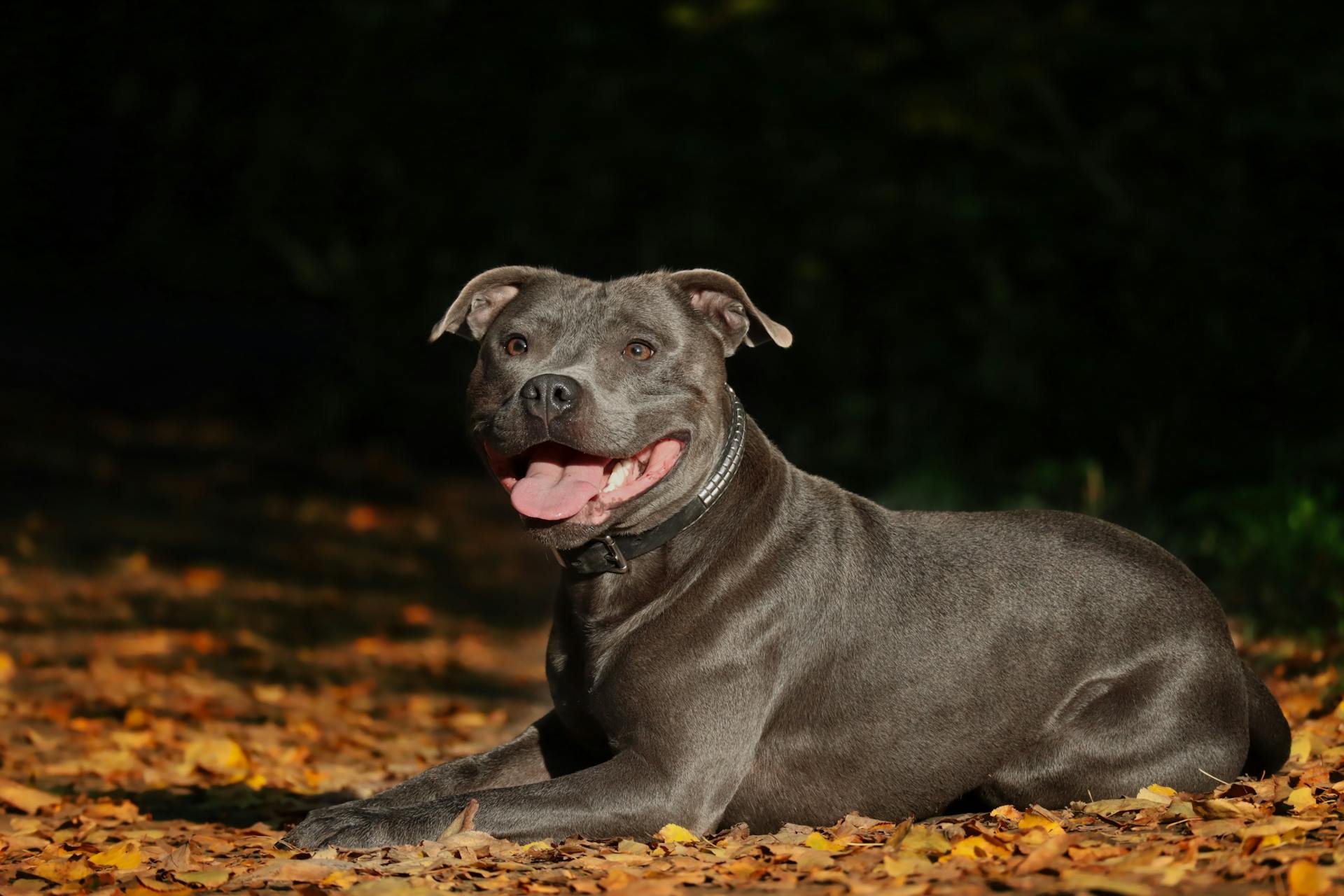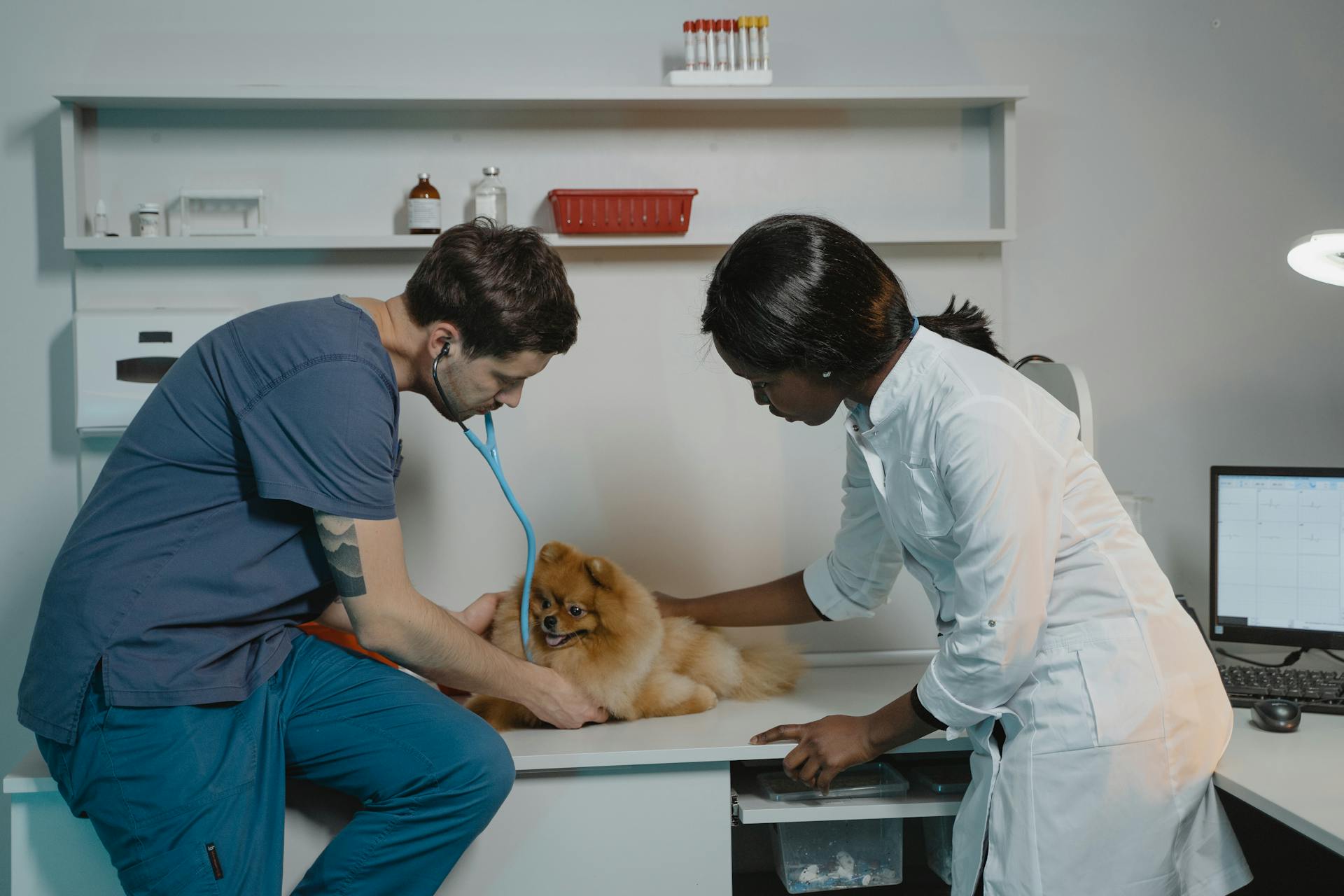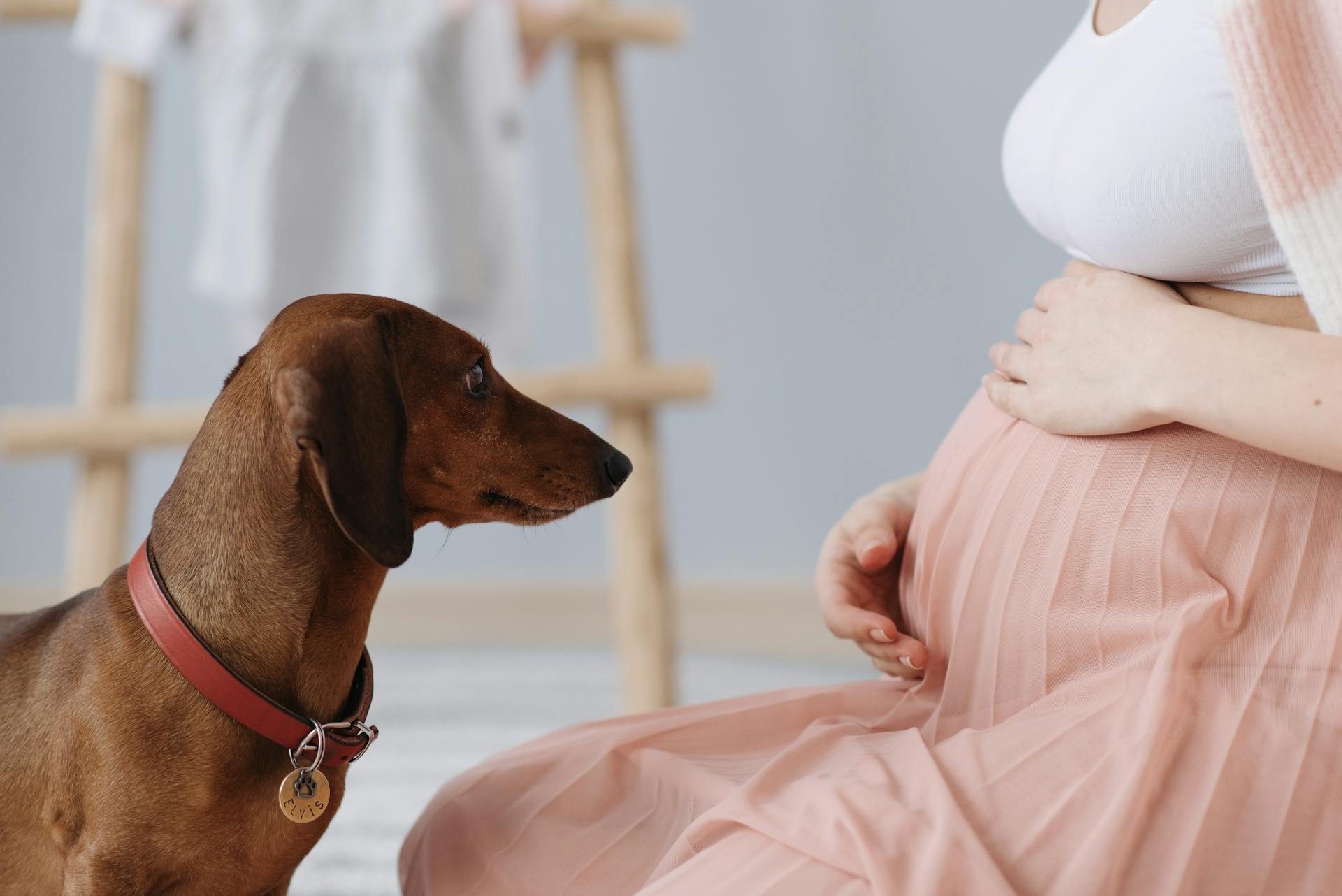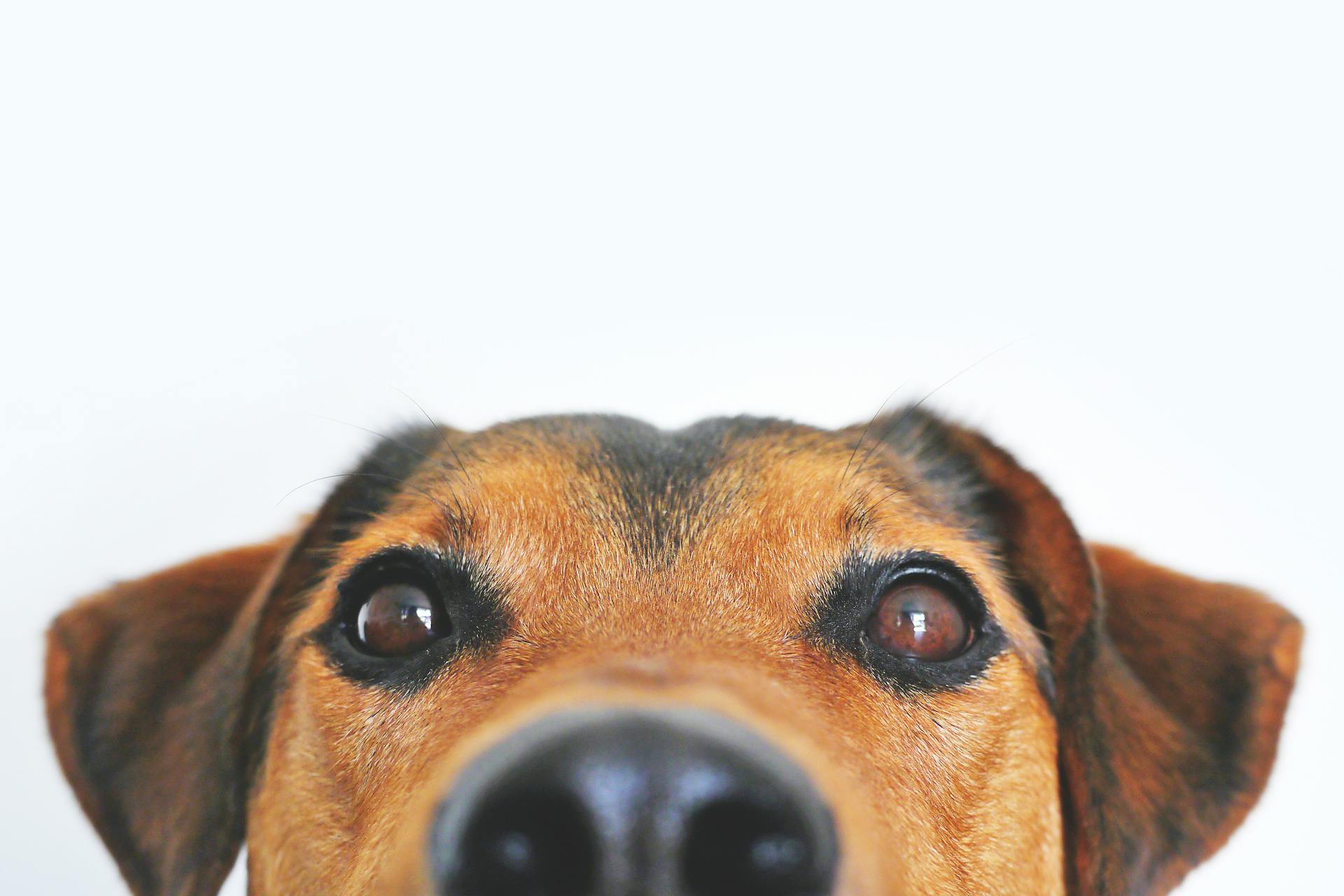
Staffies are known for their broad, flat heads and muscular build, but they're also prone to developing lumps, particularly on their necks and shoulders.
Lumps on Staffies can be caused by various factors, including fatty tumors, cysts, or abscesses.
Some lumps may be harmless, but it's essential to have them checked by a veterinarian to rule out any underlying conditions.
If you've noticed a lump on your Staffy, it's crucial to keep an eye on it and monitor its size, shape, and texture over time.
Causes and Types of Lumps
Staffies can get lumps and bumps on their skin, and it's essential to know what might be causing them. Some common causes include fat, tumors, cysts, infection, and swelling from injury or hernia.
A hernia occurs when a tissue or organ protrudes through another into an abnormal place on the body, often causing a lump or bump. Your vet can't always tell what type of lump is growing just from feeling it alone.
For another approach, see: Lump Dog Spay Incision Hernia
There are many different types of skin lumps that dogs can get, including abscesses, cysts, and haematomas. Cysts are usually harmless and can appear quickly, feel soft, and change size and shape over time.
Haematomas are swellings filled with blood, usually caused by an injury or sometimes a clotting problem. Skin tags are soft, skin lumps that look similar to warts, usually attached to the body by a small stalk.
Warts are knobbly, uneven, pink/white coloured lumps that are often slow growing and have hair coming from them. Non-cancerous tumours are slow growing and don't spread to the rest of the body.
Common non-cancerous tumours in dogs include lipomas, which are fatty skin lumps that often start very soft and become firmer as they grow. Histiocytomas are common in young dogs and tend to be red, round, angry looking, appear very suddenly, and then disappear again after a few weeks.
Cancerous tumours often grow quickly and spread to other parts of the body. Common cancerous skin lumps in dogs include mast cell tumours, squamous cell carcinomas, and melanomas.
Here are some common causes of growths in dogs:
- Age: the chance of a dog developing cancer increases with age
- Weight: being overweight means a higher chance of dogs developing tumours
- Sun Exposure: dogs with fair/no fur develop skin cancer more often, along with working dogs who spend longer outdoors
- Breed: certain breeds are more prone to tumours than other breeds
- Weakened Immune System: dogs with weakened immune systems are more likely to develop serious tumours/growths
Diagnosing and Treating Lumps
Your veterinarian has several options to determine if the lump is one that should be dealt with quickly or one that is unlikely to cause a problem. Cytology is a test that can be completed many times in your veterinary clinic and usually does not require sedation, involving your veterinarian aspirating the lump with a small needle and looking at the sample under a microscope.
If the lump is rapidly growing, a next step may be recommended, which could involve a local biopsy, where your veterinarian will take a small sample surgically and sutures will be placed over the site. The sample will be submitted to an outside laboratory for evaluation by a veterinary pathologist.
Your veterinarian will also completely anesthetize your pet and remove the entire growth in a full surgical excision. Ideally, the entire growth needs to be submitted to a pathologist to identify the type of growth and whether it was able to be completely removed.
See what others are reading: Seresto Flea Collar Small Dog
It's a good idea to regularly feel your dog for lumps, taking a photo, making a note of how big it is, and getting in contact with your vet. Every new lump should be checked because each one has the potential to be different from the last.
Here are some steps to follow for a nose-to-tail check:
- Start at their head and check their ears, eyes, and mouth
- Slowly and gently following the direction of their fur run your hands over their whole body
- Don't forget to check their legs, tail, bottom, and genitals
- Be careful when feeling their mouth, tummy, and back end, as many dogs don't like being touched in these places
- Remember – nipples are normal in both female and male dogs, so don't mistake these for lumps
- Once you've finished, give your dog a treat to make it an enjoyable experience!
Your veterinarian will ask several questions regarding the appearance of the lump, such as when it first appeared, any change in size, any change in shape, whether it is causing your dog any irritation, and whether it's causing your dog any distress.
A fresh viewpoint: Havanese Color Change
Preventing and Managing Lumps
Checking your Staffy regularly for lumps, bumps, and changes in skin colour and texture is crucial, as early treatment is often more straightforward and increases the chances of a favourable outcome.
Hairless dogs and those with white coats are at an increased risk of developing skin tumours, so they should never be kept in the sun for long periods.
Regular check-ups can help identify potential issues before they become serious, and many lumps can self-resolve or be helped along the way with non-invasive treatments.
Preventing and Managing Lumps
Dogs with fair or no fur are at a higher risk of developing skin cancer, so it's essential to keep them out of the sun for long periods.
Regular check-ups with your vet are crucial in detecting any lumps or bumps early on. If you notice anything unusual, don't hesitate to book an appointment.
Some breeds are more prone to tumours than others, so it's essential to be aware of the specific risks associated with your dog's breed.
Being overweight increases the chance of dogs developing tumours, so maintaining a healthy weight through regular exercise and a balanced diet is vital.
Age is a significant factor in the development of cancer in dogs, with the risk increasing as your dog gets older.
Dogs with weakened immune systems are more likely to develop serious tumours or growths, so if your dog has a compromised immune system, be extra vigilant when checking for lumps.
Here are some risk factors to consider when it comes to lumps in dogs:
- Age
- Weight
- Sun Exposure
- Breed
- Weak Immune System
Don't Panic!
Many lumps can self-resolve or be helped along the way with non-invasive treatments.
Early identification is the best thing for your dog, allowing you to start treatment as soon as possible.
If you have any doubts or worries, contact your vet as soon as you can for advice specific to your dog.
Remember, not all lumps are life-threatening, so there's no need to jump to conclusions.
Common Types of Lumps
Staffies can get a variety of lumps, including abscesses, which are pus-filled swellings that can be caused by an infection at a wound or injection site.
Abscesses are usually found at the site of a wound or injection, are variable in size, and can be soft and fluid-filled or hard and walled. They can be recurring or a one-time thing.
Sebaceous cysts are another type of lump that can occur on Staffies. These are benign, non-cancerous lumps that are caused by a blockage of the sebaceous gland, and are often found along the back.
Intriguing read: Pus Filled Lump on Dog
Sebaceous cysts are usually small in size, hard and firm in consistency, and have a smooth texture. They can be recurring or a one-time thing, and your Staffy can have multiple ones at once.
Histiocytomas are a type of benign tumour that can occur on Staffies, caused by an abnormal overgrowth of immune cells. They are usually found on the limbs or face, are non-draining, and are small in size.
Histiocytomas are usually red in colour, hairless, and firm in consistency. They can occur singly or in multiples, and are usually benign.
Lipomas are another type of benign lump that can occur on Staffies. These are fatty skin masses that are usually found along the rib cage, particularly in older dogs.
Here are some common types of lumps that can occur on Staffies:
Melanomas are a type of malignant tumour that can occur on Staffies, caused by an abnormal overgrowth of pigment-producing cells. They can be fast-growing and spread to internal organs quickly, so it's essential to seek veterinary advice if you suspect a malignant melanoma.
Benign melanomas are also possible, and it's still recommended to have them checked by a vet to determine if they are truly benign and to monitor them for any changes.
A different take: Benign Lump on Dog
Frequently Asked Questions
Are cancerous lumps on dogs hard or soft?
Cancerous lumps on dogs are typically hard and firm to the touch, unlike lipomas which are soft and fatty. If you suspect a lump on your dog, it's essential to consult a veterinarian for a proper evaluation and diagnosis.
Sources
- https://www.texvetpets.org/article/lumps-bumps-when-is-it-serious/
- https://www.pdsa.org.uk/pet-help-and-advice/pet-health-hub/symptoms/skin-lumps-on-dogs
- https://homehealth-uk.com/animalhealth/lumps-growths-tumours-skin-masses-on-dogs/
- https://felcana.com/blogs/blog/dog-lump
- https://www.thehonestkitchen.com/blogs/pet-wellness/why-dogs-have-a-bump-on-their-heads
Featured Images: pexels.com


